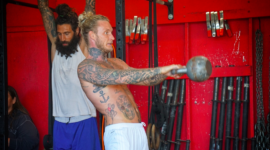
I find that for most people there is a general fear and subsequent respect for heavy weights. Any layman, for example, will lecture you on the need for “form” and several key back-saving points of performance when it comes to any form of weight training. However, much of this fear and respect is forgotten in unloaded “bodyweight” training environments, albeit calisthenics, running, or even yoga. Don’t believe me? Let the people’s opinions speak for themselves. The comments section of any social media post of people running their meniscuses off and over-striding their way to chronic back pain are barren. There’s not a single armchair quarterback ridiculing movement faults to be found. Yet, when videos of non-athletes pulling 55lbs off the ground with sub-optimal form, the world cries, “SNAP CITY!” The fear of injury with the barbell is real.
While the respect for weight is useful, I wouldn’t be so fast as to dismiss the forces at play in scenarios that don’t involve external load. Several days ago, I lectured the class before a conditioning effort that involved deadlifts and box jumps about the reality of the situation.
The reality is that force is force, whether a barbell is involved or not. I rightfully assumed that most athletes in class respected the deadlift more than the box jump with regards to force, when the fact of the matter is that, based on their bar weight, each athlete was producing and absorbing more force on a single box jump than they were on the deadlift. In some ways, their cause for concern was backwards. They were stressing about a leaky faucet when the roof was on fire.
I found myself echoing Tom Barry, who runs much of Westside Barbell, in my lecture. Part of his many key responsibilities at Westside includes hosting their podcast. He’s been Louie Simmons’ right hand man for years now. Just yesterday, he made reference to these “hidden forces” on their podcast.
He went on to point out that while we’re so focused on the forces we can see (like weight on the bar), we’re quite prone to under-respect the remarkable forces found in running, jumping, and contact sports. A world-class sprinter, for example, can put a thousand pounds of force into the ground per step. After all, you can distill movement in our lives (or sports) as a balance of applying and absorbing forces. Don’t forget that in deadlifting, bumper cars, and a grocery runs, it pays to withstand more force than the other guy.
The take home here is to recognize the reality of movement is our interaction with the forces around us. Your ability to apply force (of any kind) and withstand force (of any kind) is precisely an indicator of your ability to perform and your ability to stay safe (even when weights are not involved).
Logan Gelbrich
@functionalcoach
6/26/17 WOD
In 12 minutes, establish a heavy single snatch..
Then, complete the following for time:
15 Snatches (@70%)
Then, complete the following for quality:
40 V-Ups
40 Russian Twists (2-ct)
40 Reverse Crunches

